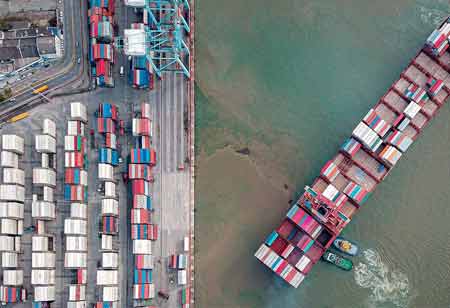THANK YOU FOR SUBSCRIBING
THANK YOU FOR SUBSCRIBING

By
Logistics Transportation Review | Wednesday, October 09, 2024
Stay ahead of the industry with exclusive feature stories on the top companies, expert insights and the latest news delivered straight to your inbox. Subscribe today.
Intermodal logistics promotes sustainability, reduces carbon footprint, and offers a cost-effective alternative.
FREMONT, CA: Intermodal logistics is the planning and execution of the movement of products from their point of origin to their final destination via many modes of transportation. Containerized cargo can comprise a wide range of commodities, from frozen food for a grocery store chain to new vehicles for a dealership. A shipping container transporting these items may have to travel over an ocean and thousands of miles of highways to reach its destination. This is where the various intermodal modes of transportation, such as cargo ships, trains, and trucks, come in. They not only enable the voyage but also improve its efficiency. This applies to both the domestic and international intermodal shipping processes.
Major advantages of intermodal logistics are noted below:
Better sustainability and reduced carbon footprint: Intermodal transport is not only less expensive than utilizing a single mode of transportation, but it is also better for the environment because it uses less polluting modes of transportation, such as trains. Trucks create greenhouse gases, such as carbon dioxide, when they use fossil fuels like gasoline and diesel to operate. As it turned out, the transportation industry was more responsible for carbon dioxide emissions in the US in 2023 than power production. These gases can hurt human health and contribute to climate change.
By stacking intermodal containers twice, an intermodal train can transport the equivalent of 280 truckloads. That represents a large decrease in the number of trucks on the route, resulting in a significant decrease in greenhouse gas emissions. Fewer trucks transporting merchandise on the highway reduce traffic congestion. When traffic is reduced, highway vehicles spend less time idling and produce less greenhouse gases. An improved fuel economy can also help reduce gas prices.
Cost-effective alternative: Shipping can be one of the most costly aspects of the product distribution process. According to recent survey data, nearly half of retailers spend more than 10 percent of the entire order value on shipping costs.
Using intermodal freight transportation to manage cargo movement can result in considerable cost reductions in the following ways:
It uses fewer resources: Intermodal logistics enables the movement of more goods while using fewer resources. For example, instead of relying only on trucks for cross-country transportation, a train may be employed for a portion of the journey, which can carry much more freight.
It reduces the needed manpower: Consider paying the crews who also transport the intermodal shipment. Instead of paying individual truck drivers to deliver a few shipping containers each, a single train crew will be compensated for transporting possibly more than 200 times what a single truck can transport alone.
I agree We use cookies on this website to enhance your user experience. By clicking any link on this page you are giving your consent for us to set cookies. More info





